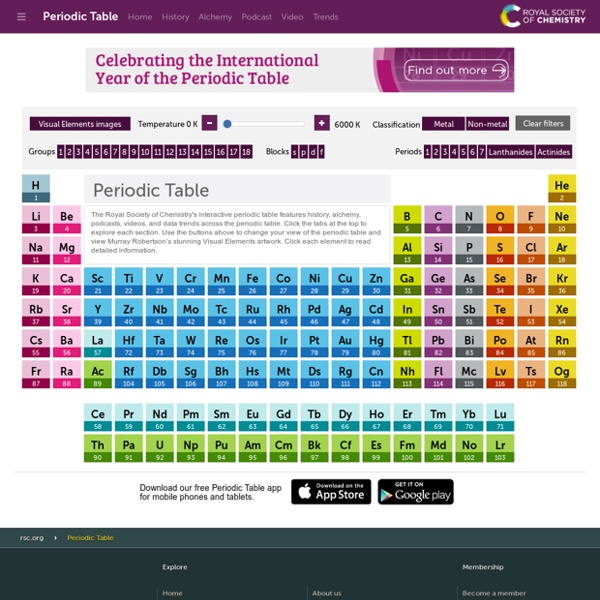



http://www.rsc.org/periodic-table
Related: Taules per Secundària i BATXThe Elements by Theodore Gray My book The Elements is based on photographs I've been collecting at my website periodictable.com for many years. The website includes not just pictures, but also more detailed descriptions than we could fit in the book, and most importantly, it includes full 360-degree rotating videos of almost all the objects. You really won't find this kind of resources anywhere else for any other subject, so please enjoy. If you don't have the book yet, please don't think this is page is a substitute for the real thing. Metal A metal (from Greek "μέταλλον" – métallon, "mine, quarry, metal"[1][2]) is a solid material (an element, compound, or alloy) that is typically hard, opaque, shiny, and features good electrical and thermal conductivity. Metals are generally malleable—that is, they can be hammered or pressed permanently out of shape without breaking or cracking—as well as fusible (able to be fused or melted) and ductile (able to be drawn out into a thin wire).[3] 91 of the 118 elements in the periodic table are metals. The meaning of "metal" differs for various communities.
Top Tools to Create Instructional Videos As we head into a new school year, many things will be different in the library. One area that may be different is how librarians deliver instruction to students. Several tools are available online to help provide instruction through videos: BBC Bitesize - KS3 Chemistry - The periodic table - Revision 1 All the different elements are arranged in a chart called the periodic table . A Russian scientist called Dmitri Mendeleev produced one of the first practical periodic tables in the 19th century.
Pictures, stories, and facts about the element Hydrogen in the Periodic Table Actinolite asbestos. The name "asbestos" used to mean a wonder-material, an insulator without equal and a strengthening fiber so cheap and strong it was used in building materials worldwide. Today the name means nothing but death and ruin. Asbestos had been used so widely and for so long that it must have seemed beyond credibility when evidence first started appearing that it might be harmful. It is, after all, just a natural mineral, a rock dug from the ground.
Changing Materials - Iron Bookmarked webpages about iron "Iron (Fe) is the second most common metal on Earth, and the most widely-used metal by humans. It is element 26, a transition metal in Group 8. Its symbol is Fe, from the Latin word for iron, ferrum. The Periodic Table's Endangered Elements Click to enlarge We’re all familiar with the periodic table, but the majority of non-chemists probably aren’t familiar with the everyday uses of some of the many elements it contains. Some elements that many haven’t heard of find uses in technologies or applications we take for granted – but the supplies of these elements on Earth are not infinite. Today’s graphic, in a collaboration with the American Chemical Society’s Green Chemistry Institute, looks at some of the endangered elements in the periodic table, and why we might miss them when they’re gone.
Science Paper Model - 3D Periodic Table Free Papercraft Download This science paper model is a three-dimensional (3D) Periodic Table, designed by soilshop. If you are a chemistry teacher, it might be helpful in your teaching. A periodic table is a tabular display of the chemical elements, organized on the basis of their atomic numbers, electron configurations, and recurring chemical properties. Elements are presented in order of increasing atomic number.
How iron is made - material, manufacture, making, history, used, processing, parts, structure, procedure, industry, History, Raw Materials, The Ore Extraction and Refining Process Background Iron is one of the most common elements on earth. Nearly every construction of man contains at least a little iron. It is also one of the oldest metals and was first fashioned into useful and ornamental objects at least 3,500 years ago. Pure iron is a soft, grayish-white metal. Although iron is a common element, pure iron is almost never found in nature.
Home Copyright Copyright is a legal right created by law that gives the creator of an original work exclusive rights to its use and education. Copy protection exists from the moment a work is created. If you reproduce, republish, or redistribute something produced by someone else without the copyright holders permission, there is a good chance you are violating copyright law. Fair Use 2018 in review: Compound Interest's Top 5 graphics With 2018 coming to an end, it’s time to reflect on the graphics from the past twelve months. Here, we’ll look at the 5 most popular graphics on the site this year, as well as some of my favourites! For all of the graphics featured in this round-up, clicking on the graphic will take you to the original post, where you can read the accompanying article, view a larger image, and download a PDF of the graphic. 2018 was the first time I’ve posted fewer than 100 new graphics on the site over the course of the year. However, in case you think that’s because I’ve been being a bit lazy, that’s largely the result of switching from weekly to monthly chemistry news round-ups. Doing so has actually given me a bit more time to produce other graphics!